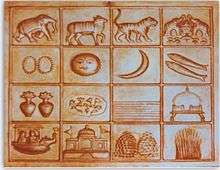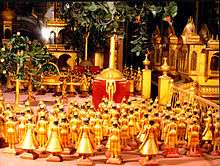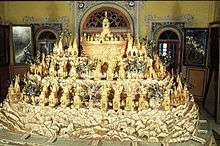Ajmer Jain temple
| Ajmer Jain temple | |
|---|---|
| Soniji Ki Nasiyan | |
 Ajmer Jain Temple | |
 Location within Rajasthan | |
| Basic information | |
| Location | Ajmer, Rajasthan |
| Geographic coordinates | 26°27′N 74°38′E / 26.45°N 74.64°ECoordinates: 26°27′N 74°38′E / 26.45°N 74.64°E |
| Affiliation | Jainism |
| Deity | Rishabhanatha |
| Festivals | Mahavir Jayanti |
| Architectural description | |
| Creator | Seth Moolchand Soni |
| Date established | 1864-1895 |
| Part of a series on |
| Jainism |
|---|
 |
|
Jain prayers |
|
Ethics |
|
Major figures |
|
Major sects |
|
Festivals |
|
Pilgrimages |
|
|
The Ajmer Jain temple, also known as Soniji Ki Nasiyan, is an architecturally rich Jain temple. It was built in the late nineteenth century. The main chamber, known as the Swarna Nagari "City of Gold", has several gold-plated wooden figures, depicting several figures in the Jain religion.
Kurt Titze, in his book, "Jainism: A Pictorial Guide to the Religion of Non-Violence" (1998, p. 143), writes on Soniji Ki Nasiyan:[1]
- "Ajmer's main attraction is - for the Jainas - the prominently situated Nasiayan Digambara Temple, or rather the two-storied Svarana Nagara Hall behind the temple, better known as the Museum. Both the temple and the museum were built and are still owned by the Sony family of Ajmer. The temple, dedicated to Rishabha or Adinatha in 1865, was constructed of red sandstone in a matter of a few years, but it took twenty-five years, from 1870 to 1895, to fashion - by artisans at Jaipur - the thousands of individual parts required to assemble a three-dimensional replica of the story of Rishabha in accordance with an old manuscript by Acharya Jinasena.
- The thought to have such a three-dimensional model for educational purposes occurred to Seth Moolchand Soni, who was born in 1830, only after the completion of the temple. His death in 1891 prevented him from seeing his ambitious work in its finished state.
- In many Jaina temples one sees painted or figurative representations of the 'five auspicious events' (pancha-kalyanak) in the life of every Tirthankara: conception, birth, renunciation, enlightenment, and salvation (moksha or nirvana). The one at Ajmer, now over a hundred years old, is by far the largest and most artistic plastic representation of that much-loved mythological narrative. A specially designed hall of 24.3 m by 12.2 m had to be build to display it effectively. It is open to visitors of all religions every day all the year round for a very small entry fee."
History
Greatly revered by the Digambar sect of the Jains, the Nasiyan temple is dedicated to Lord Rishabhdev, first of the 24 Tirthankars [religious path makers of the Jains] by Rai Bahadur Seth Moolchand and Nemichand Soni. It is situated on Prithvi Raj Marg in Ajmer, the heart of Rajasthan state in India. The foundation of this magnificent Jain temple was laid on 10 October 1864 and the image of the first Tirthankar Lord Rishabhdev (Adinath), was installed in the Sanctum Sanctorum on 26 May 1865. This work was carried out under the able guidance of the great scholar Pandit Sadasukhdasji of Jaipur.
The name of the temple is Siddhkoot Chaityalaya. It is also known as 'Red Temple' as it is built of red sand stone or 'Nasiyan of Seth Moolchand Soni' signifying the founder’s name. After the Svarna Nagri was added to the temple in 1895 A.D. it popularly began to be called as 'Sone ka Mandir' or 'Soni Mandir' emphasizing the golden structure as well as the family name. The halls of this temple are adorned with fascinating series of large, gilt wooden figures and delicate paintings that display scenes from Jain scriptures.
Main Temple:
The entrance gate of the temple is made of red sand stone brought from Karauli. In front of the gateway is the marble staircase, leading to the main temple, which is embellished with the images of the Tirthankars.
Vedi’s:
The central image is of Lord Rishabhdev seated in the "Samavasharana" - in which He imparts true knowledge to the suffering humanity, so that they get liberated from the entanglements of life and death. In the year 2005, the 3 Vedi's were renovated and all the idols of Tirthankaras were re-installed amidst religious rituals and ceremonies. In this portion only Jains are allowed to perform their religious rituals.
Manastambha:
On entering this historical temple one gets the view of the beautifully and artistically designed 82 feet high Manastambha. R. B. Seth Tikamchand Soni laid the foundation and R. B. Seth Sir Bhagchand Soni built this Manastambha. He, along with his sons Prabhachand, Nirmalchand & Sushilchand consecrated and installed the images of the Jain Tirthankars in it. A big function was held for ten days in June 1953, where along with the members of the Soni family, thousands of others participated.
Library:
In the year 1974, in the auspicious presence of 108 Acharya VidhyasagarJi Maharaj, a big library was established by R.B. Seth Sir Bhagchand Soni. The library houses rare Jain scriptures which are extensively used for research by scholars.
Visitors
The temple is being visited by many tourists annually. Distinguished Visitors include India's first President Dr. Rajendra Prasad, Prime Ministers Jawaharlal Nehru, Indra Gandhi, Morarji Desai & Rajiv Gandhi, Commander-in-Chief General K.M.Kariappa. Pre independence the Viceroy and Vicerene of India Lord & Lady Irwin and Lady Willingdon also visited. [2]
Svarna Nagri
It came to R.B. Seth Moolchand Soni’s mind that 5 Kalyanakas of Lord Rishabhdev could be displayed in models. Accordingly, the work started in Jaipur and it took 25 years to complete these replicas of Ayodhya and Mt. Sumeru. The whole structure, covered with gold leaf, is made according to the descriptions contained in Adi Purana written by His Holiness Shri Jina Sen Acharya.
On completion, the models were displayed in Museum Hall in Jaipur. A big fair was celebrated for ten days in 1895 A.D which was attended by H.H.Maharaja Madhosinghji of Jaipur. The models were thereafter installed in the building behind the Main Temple. This Hall is richly painted in variegated colours, and the walls and ceiling are covered with glass mosaic work.
Garbha Kalyanak (Conception):
The great soul of the Lord is emulated and glorified by the Celestials even six months before He comes into his mother’s womb. Saudharma Indra, the Lord of the celestials, ordered Kubera to rain down priceless jewels in the palace of his father Maharaj Nabhiraj, thus announcing the coming of the Saviour of the World. The golden city of Ayodhya was constructed by the Celestials according to the wishes of Indra. After six months, the mother Marudevi saw sixteen symbolic dreams, signifying that she was going to be the mother of The Tirthankar.
Janma Kalyanak (Birth):
When Lord Rishabhdev was born in the royal palace in the center of Ayodhya, the thrones of Indras vibrated indicating the birth of the Divine Child. The celestials marched towards the city with great majesty. Indra, after completing three rounds of the city took the Baby Tirthankar on the 'Airawat' (Elephant) to Mt. Sumeru. On this golden mountain lies Panduk Shila upon which the Baby Tirthankar was seated for Mahabhisheka (the great sacred ablution) ceremony. The ablution was performed by the waters of the distant ocean Kshira Samudra, brought in 1008 huge pitchers. After this, the celestial company returned the Baby Tirthankar to the Palace of Maharaj Nabhiraj leaving several Celestials as child playmates with Him. Rishabhdev attained manhood and succeeded his father to the throne of Ayodhya.
Tap Kalyanak (Renunciation):
As Rishabhdev became engrossed in worldly affairs, Indra appeared before Him with Apsara Nilanjana. She danced before Him and suddenly disappeared, discarding her mortal coil. This reminded Rishabhdev of the transient nature of the World and He decided to renounce it.
Installing in his place his eldest son Bharat, He left the palace followed by 4000 other kings. Indra followed by the other Celestials, took Rishabhdev in procession to the Triveni, the confluence of the Ganges, the Jamuna and the Saraswati at Prayag ( Allahabad ) where under the shade of the Akshayavat (sacred Banyan Tree) Rishabhdev gave up the world, including his clothes and gave himself to contemplation. He pulled out his hair (Kesh Lonch) by his own hands depicting his extreme detachment to all worldly and bodily comforts. Lord Rishabhdev took his first meal after one year of austerities and penance. Raja Shreyans, the king of Hastinapur, had the good fortune of being the first person to offer him a meal in the form of Sugarcane Juice on the 3rd day of the bright fortnight of the month of Vaishakha. This occasion is celebrated even today as "Akshaya Triteeyaa".
Keval Jnan Kalyanak (Omniscience):
After 1000 years of austerities and penance, Lord Rishabhdev attained Keval Jnan (Omniscience) at Mount Kailash. Indra arranged a beautiful place of congregation known as "Samavasharana" where the Lord preached the doctrine of non-attachment to the world. Celestials, humans, and even birds & animals gathered to listen to Him. Tirthankars attain the power of walking in sky after attaining Omniscience. 225 Golden lotuses are placed beneath the Lord’s feet during his travel by Indra.
Moksha Kalyanak:
On Mount Kailash where Lord Rishabhdev attained Salvation or Nirvana, his eldest son Bharat, the first Chakravarty (emperor of Bharat Kshetra), constructed seventy two magnificent golden temples. [3]
Photo gallery
-

Temple front view
-

Temple full view
-

Manasthamba
-

Entrance of the temple
-

Main vedi with Rishabhanatha idol
-

Vedi on the west side
-

Vedi on the east side
-

Dipiction of Ayodhya
-

Dipiction of Mount Sumeru
-

Dipiction of Celestial Air Ship
-

Dipiction of Sixteen Symbolic Dreams
-

Dipiction of new born Rishabhanatha with her mother
-

Dipiction of Procession of Celestials
-

Dipiction of Baby Rishabhanatha on Airawat Elephant
-

Dance of Apsara Nilanjana
-

Rishabhanatha in meditation
-

Rishabhanatha performing 'Kesh Lonch"
-

Shreyans, the king of Hastinapur offering Sugarcane juice to Rishabhanatha
-

Rishabhanatha moving over golden lotus after attaining Omniscience
-

Rishabhanatha in Samosharan on Mount Kailash
-

Ground floor hall
-

Jain Museum, Ajmer
See also
References
- ↑ Kurt Titze; Klaus Bruhn (1998). Jainism: A Pictorial Guide to the Religion of Non-violence. Motilal Banarsidass Publ. p. 143. ISBN 978-81-208-1534-6.
- ↑ "Magazine | Jain Culture | Temples | India | Rajasthan ►Ajmer ►Soniji Ki Nasiyan". Herenow4u.net. Retrieved 18 May 2012.
- ↑ India. "Soniji Ki Nasiyan, National Highway 79, Ajmer | Tourist Attractions & Sightseeing, Attractions & Landmark | CitySeekr". Jaipur.cityseekr.com. Retrieved 18 May 2012.